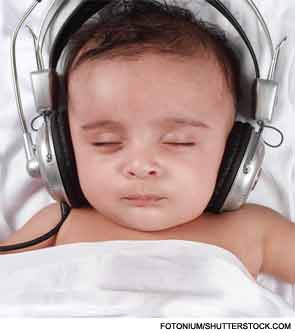Explore This Issue
June 2014
As Blake Papsin, MD, otolaryngologist-in-chief at The Hospital for Sick Children in Toronto, was covering for a colleague on the ward one day, he walked into a room and saw a device he had never seen before—an infant sleep machine (ISM).
“The parents told me that a website talked about ISMs and how good they were,” he said. “I asked them to turn it down so we could talk.”
The encounter with the sleep machine in the infant’s room caused Dr. Papsin to head to his laboratory and return with a sound pressure meter. Using the meter, he measured a sound level of 85 A-weighted dB (dBA), which is higher than exposures allowed in industrial work environments without hearing protection.
Some parents use the machines to cover ambient noise and help babies sleep; however, a new study by Dr. Papsin and colleagues, published in the April issue of Pediatrics, is raising some concerns about the machines’ long-term effects on infant hearing (Pediatrics. 2014;133:677-681).
The Study
To conduct the study, the researchers used 14 ISMs widely available in the United States and Canada. Each machine produced between one and 10 different sounds such as white noise, nature sounds, mechanical sounds, and heartbeats. Sound levels were obtained using a sound meter in a sound booth. The meter’s microphone was fitted with a 2-mL coupler to simulate the location of the tympanic membrane in an infant.
The ISM and meter were placed on separate tables of equal heights. Readings were taken at 30 cm to mimic placement on a crib rail or within the crib, 100 cm to simulate placement on a nearby table, and 300 cm to see what levels might be found if the machine was placed across the room. At each distance, the machine was activated three times for 30 seconds each.
“Many parenting websites encourage parents to use these machines at full volume,” said Dr. Papsin. “Some suggest that, at a minimum, the machine has to be louder than the baby’s cry. This led us to do our measurements with the ISMs as loud as they would go.”
—Blake Papsin, MD
Maximum volume sound levels at 30 cm were greater than 50 dBA for all 14 devices, and three machines had output higher than 85 dBA. At middle distances, all ISMs produced sounds higher than 50 dBA. Even at 200 cm, all but one of the ISMs still produced sounds at levels higher than 50 dBA.
Leave a Reply